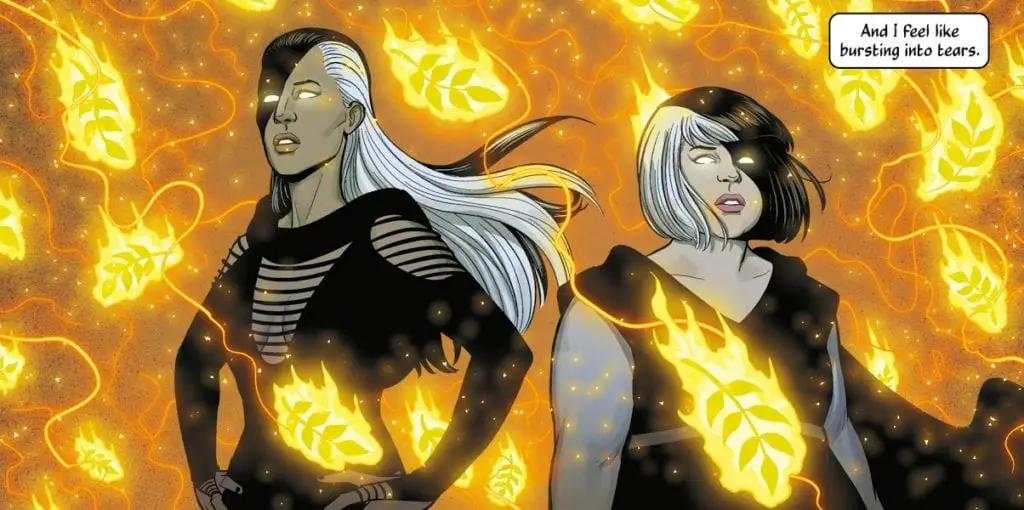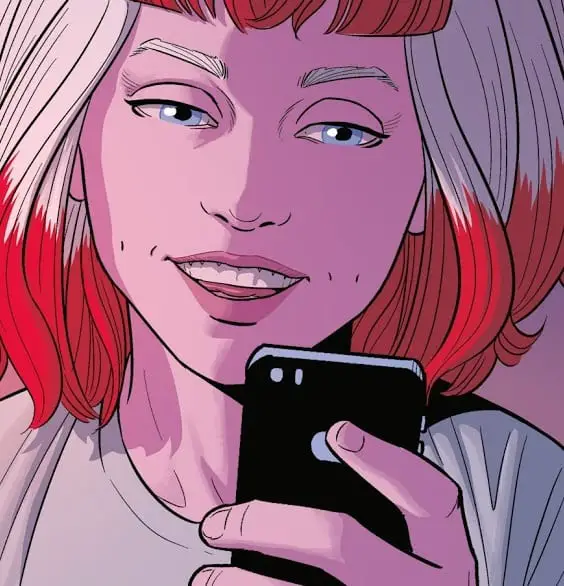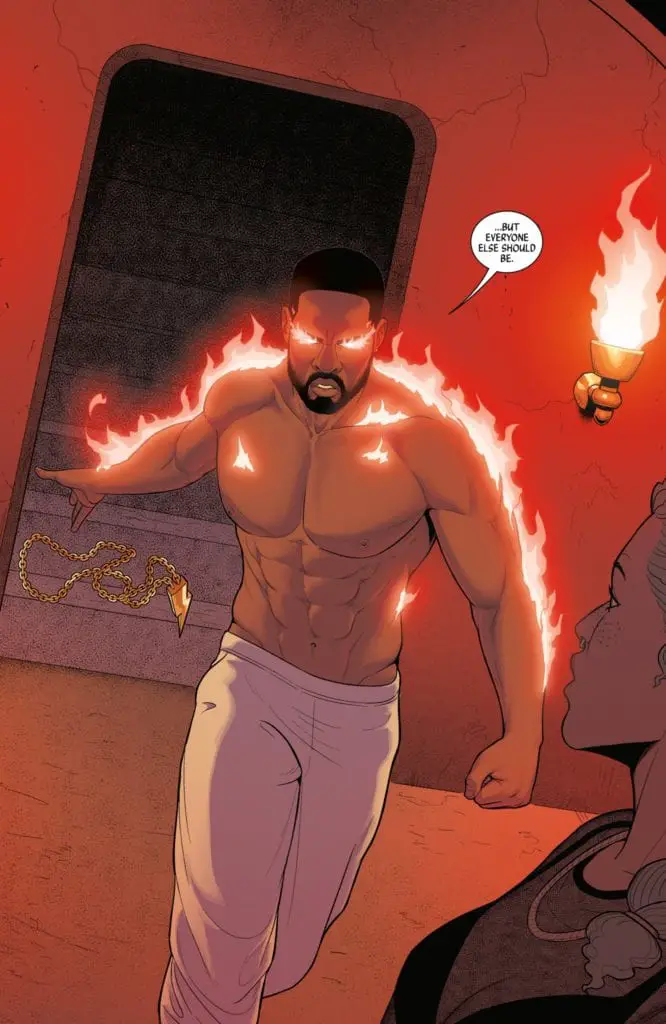Back in Uni, I read “The Turn of the Screw” by American writer Henry James. While the story itself was pretty alluring, its true charm lay in its narrative devices, and the effect they have on the reader. Simply put, it’s a matter of encroachingly claustrophobic ambiguity. You never actually know if the governess is going mental, or if there’s indeed some sinister supernatural influence at play in the house. Furthermore, the dialogue between both possibilities is in itself a conflict. And if you read deep enough into it, you’ll definitely feel the tension. Fast forward to the present day and my response to reading the latest WicDiv issue is not too different.
Kieron Gillen and Jamie McKelvie have proven joyfully unafraid to explore character development, intertextuality, and even Shakespearian despair with this baby. They’ve also been more than willing to let us become attached to their characters. But then, they’ve also been merciless in their violent subversion of everything and bringing the temple down. The preceding issue compelled us to look back on what we’ve read and think about it on a deeper level. This one will do the same, for us to gasp in horror.
Issue #35
“Necessity”
The cover hints at yet another leap into the past, this one back to 1923, where it all began, publication-wise. 34 issues later, and a lovely special on the matter, a return to this decade is bound to unveil some new knowledge. And if wee Minerva’s unexpectedly ominous presentation is anything of a clue, it’s going to be horrendous news. We find ourselves at Ananke’s tearful farewell to this Recurrence’s final four: Susanoo, Amaterasu, Amon-Ra, and Minerva, whose grin is the concerning sight we hadn’t considered the first time. At the final count of four, the surviving Gods snap their fingers, each pointing at the other to ensure the pact’s absolute success.
Minerva snaps differently from the others, though, casting a shield to deny Amaterasu’s snap. Thus, the suicide wheel tumbles, ‘accidentally’ sparing Minerva and Susanoo; the former disguises this is as fear of dying while the latter gives her a comforting hug. Duplicitous Minerva uses this to her advantage and claims Susanoo’s head. The treacherous child emerges from the flames to meet up with Ananke, who looks strangely reticent. Talk about hard characters to read. But it gets even stranger.

As the child places Susanoo’s still living head next to Morrigan’s, Set’s… and a never before seen Persephone’s, her speech starts to closely resemble that of the Ananke we know. On the other hand, Ananke’s words reveal an uncharacteristic fear, akin to a child afraid to die. It’s then that the Maid (Minerva) kills the Crone (Ananke) and magically consumes the heads, leaving only skulls behind. So much for thinking Luci, Tara, and Inanna were not fucked. As a result, ‘Minerva’ stands revitalized, flaunting glowing skulls in her eyes, something we more closely associate with Persephone. Peculiar.
The musical/intertextual 1-2-3-4 motif proved deadlier than we had anticipated. We’ve already seen Ananke die gruesomely at the hands of modern day Persephone. But this time around, one can plausibly think of a swap between Minerva and Ananke, which would mean the latter has just murdered the former, a Maid in a Crone’s body. Therefore, if my conjecture holds true, the physical Ananke we know may actually be 1923’s Minerva. SHIVER.
Fast forward to the present day then.

Asshole parent David Blake, otherwise known as asshole fake God Woden, interrupts Minerva’s sleepytime by holding her at gunpoint. It’s interrogation time after he found out Minerva attempted to take Sakhmet’s head, which didn’t work quite as well as she had expected. We now know of the ancient link between Minerva and Ananke, but Woden doesn’t, thus Mini’s claim that Ananke promised to break her out of the two-year lifetime curse is at least feasible-sounding to Woden. According to her, she merely stayed quiet while Ananke did her head-collecting. After the Crone’s death at Persephone’s finger snap, Minerva attempted to take the fourth head to somehow save herself.
Or so she says. That’s how things stand Minerva-wise. But why is Woden so interested in this information? Certainly he has no good deed in mind, but a more pressing concern snatches his attention. Woden teleports away, leaving Mini behind to do away with the facade (the outlines of which we can’t quite tell), as she observes Persephone, Urdr, and Mimir’s escape with the help of Cass’ pals from her laptop. It seems proximity with Cass allows Verdandi and Skuld to regain their divinity, which is nice and helpful. Alas, the heroes’ freedom doesn’t stop Woden from taking Mimir back, who’s just a head.
Persephone (whose inner monologue dwells on the matter of friendship) and the Norns return to the lab to try and rescue Mimir. The bodyless God is nowhere in sight, but an interesting development unfolds: Urdr gets a text from Minerva. At this point, Cass knows she can’t trust anyone, so she takes care not to reveal much even to Minerva. A wise decision. But Minerva knows just what to text—something devious, as foreshadowed by an unsettling-looking grin. The Maid admits she had been withholding information, but adds some specific information about a secret room behind Baal’s mural in Valhalla.

Laura asks that Cass and her Norns get the word out about the shit-show that has occurred. In the meantime, she will go and look at this secret room. Although Persephone doesn’t trust Minerva, she doesn’t fear her either. Persephone finds the mural (hard to miss it, really) and destroys it, revealing a secret stairway leading down. Under the nighttime setting, the grandiose Baal-centric design looks slightly unnerving. Furthermore, the contrasting setting and circumstance starts to undermine Baal’s persona.
Meanwhile, Mini puts her best oblivious kid act and wakes Baal, claiming Persephone mentioned the secret room. The Sky God freaks out and shazams his way to Valhalla.
At the end of the stairs, Laura finds her way to a small red chamber with an altar. Intertwined with the discovery panels, we see flashbacks of pre-Godhood, belligerent Cassandra Igarashi. In this flashing retrospective, the journo questions which Baal they were talking about. Initially, she believed him to be Baal Hammon, Sun God of Carthage. There was something peculiar about this God’s worship: it featured literal child sacrifice. Baal, with the most annoyed expression I’ve seen in comics, denied this, claiming instead to be Baal Hadad, a thunder God. Alas, it just so happens that this secret altar boasts a few skeletons, disturbingly small skeletons at that.
So much for the Thunder God facade. Baal furiously discards it by casting aside his cool-ass thunder chain. In its stead, we get fire all over. Baal Hammon has finally revealed himself in full. Maybe Sakhmet was not actually the most dangerous God around. After Baphomet’s reveal as actually Nergal and Mimir’s surfacing, why would this be a surprise? We’ve had death that far exceeds Game of Thrones in both horror and brains. Should we really be surprised one of the good guys was evil along—again? Maybe, maybe not. Gods know I was.
That’s it for this latest issue, my lovelies. So far this arc has raised the stakes with vengeful poise and swiftness. Gillen and McKelvie haven’t had a single dull moment here, so we can only anticipate something even better, either for triumph or tragedy.

The Wicked + The Divine Issue #35 Credits
Writer: Kieron Gillen
Art / Cover: Jamie McKelvie, Matt Wilson

